Nursing Assignment: Transition Challenges for New Graduate Nurses
VerifiedAdded on 2021/04/21
|9
|2204
|50
Report
AI Summary
This report, based on a nursing assignment, explores the challenges faced by a newly graduated registered nurse (RN) with six months of experience while leading a quality improvement initiative focused on hand hygiene at Sturt Health Service. The report details the RN's role in orienting the team, explaining project goals, and allocating tasks. It highlights potential challenges such as managerial inexperience, resistance to change, and transition shock. Strategies to manage these challenges are discussed, including improved communication, seeking mentorship, and embracing opportunities for leadership development. The report emphasizes the importance of evidence-based practices, such as mentorship programs and positive leadership qualities, to facilitate a smooth transition and effective team leadership. The goal is to improve patient safety by implementing a hand hygiene protocol.
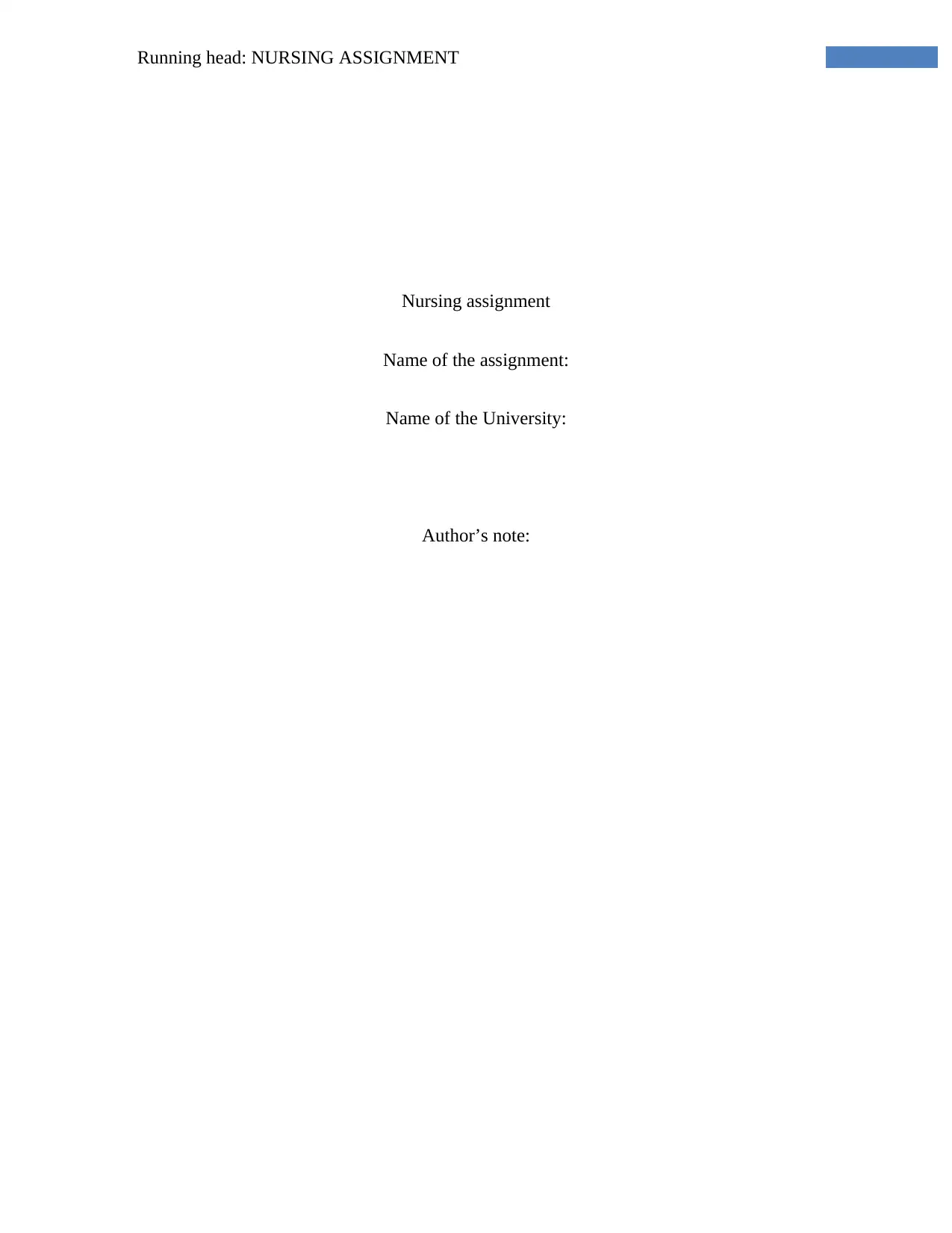
Running head: NURSING ASSIGNMENT
Nursing assignment
Name of the assignment:
Name of the University:
Author’s note:
Nursing assignment
Name of the assignment:
Name of the University:
Author’s note:
Paraphrase This Document
Need a fresh take? Get an instant paraphrase of this document with our AI Paraphraser
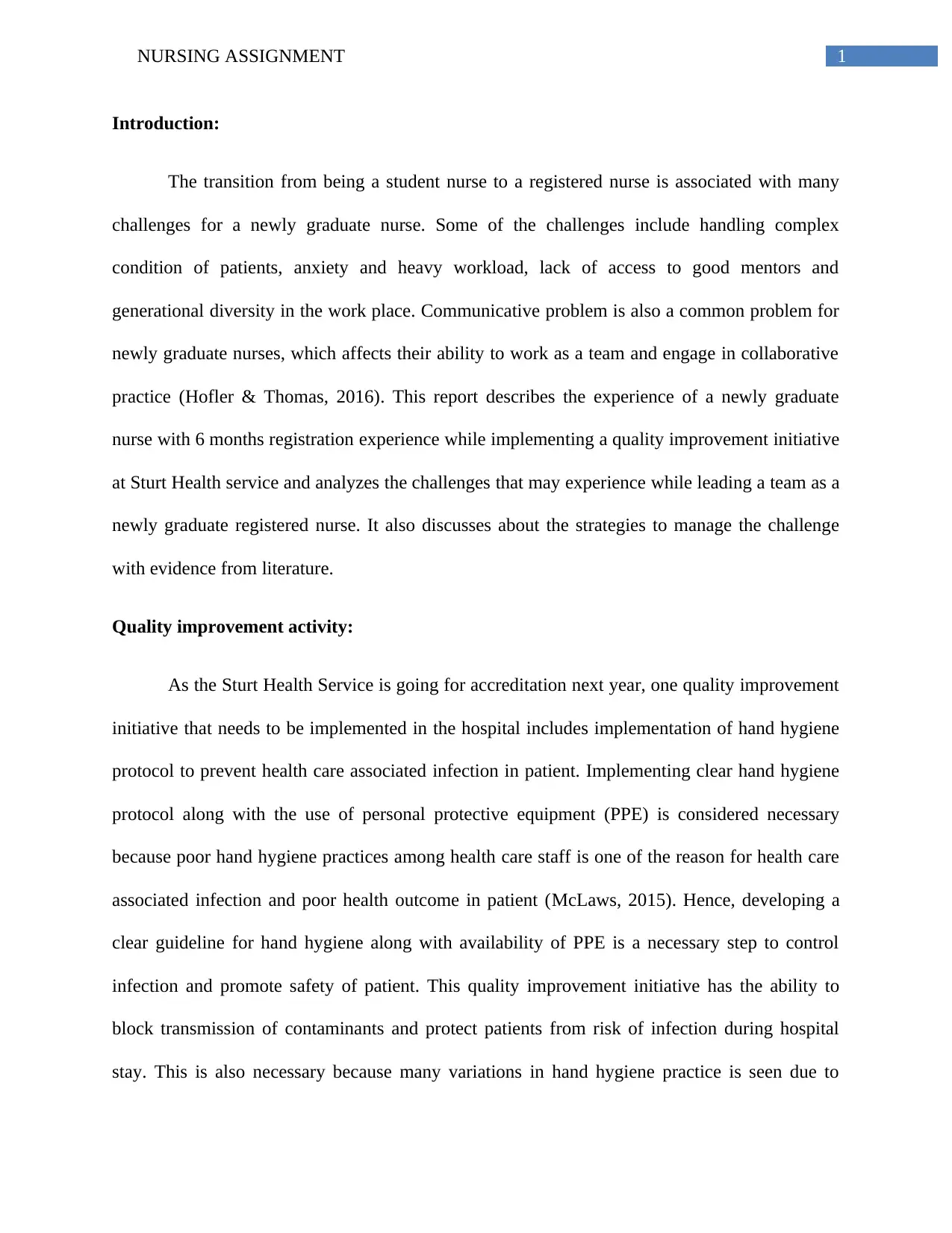
1NURSING ASSIGNMENT
Introduction:
The transition from being a student nurse to a registered nurse is associated with many
challenges for a newly graduate nurse. Some of the challenges include handling complex
condition of patients, anxiety and heavy workload, lack of access to good mentors and
generational diversity in the work place. Communicative problem is also a common problem for
newly graduate nurses, which affects their ability to work as a team and engage in collaborative
practice (Hofler & Thomas, 2016). This report describes the experience of a newly graduate
nurse with 6 months registration experience while implementing a quality improvement initiative
at Sturt Health service and analyzes the challenges that may experience while leading a team as a
newly graduate registered nurse. It also discusses about the strategies to manage the challenge
with evidence from literature.
Quality improvement activity:
As the Sturt Health Service is going for accreditation next year, one quality improvement
initiative that needs to be implemented in the hospital includes implementation of hand hygiene
protocol to prevent health care associated infection in patient. Implementing clear hand hygiene
protocol along with the use of personal protective equipment (PPE) is considered necessary
because poor hand hygiene practices among health care staff is one of the reason for health care
associated infection and poor health outcome in patient (McLaws, 2015). Hence, developing a
clear guideline for hand hygiene along with availability of PPE is a necessary step to control
infection and promote safety of patient. This quality improvement initiative has the ability to
block transmission of contaminants and protect patients from risk of infection during hospital
stay. This is also necessary because many variations in hand hygiene practice is seen due to
Introduction:
The transition from being a student nurse to a registered nurse is associated with many
challenges for a newly graduate nurse. Some of the challenges include handling complex
condition of patients, anxiety and heavy workload, lack of access to good mentors and
generational diversity in the work place. Communicative problem is also a common problem for
newly graduate nurses, which affects their ability to work as a team and engage in collaborative
practice (Hofler & Thomas, 2016). This report describes the experience of a newly graduate
nurse with 6 months registration experience while implementing a quality improvement initiative
at Sturt Health service and analyzes the challenges that may experience while leading a team as a
newly graduate registered nurse. It also discusses about the strategies to manage the challenge
with evidence from literature.
Quality improvement activity:
As the Sturt Health Service is going for accreditation next year, one quality improvement
initiative that needs to be implemented in the hospital includes implementation of hand hygiene
protocol to prevent health care associated infection in patient. Implementing clear hand hygiene
protocol along with the use of personal protective equipment (PPE) is considered necessary
because poor hand hygiene practices among health care staff is one of the reason for health care
associated infection and poor health outcome in patient (McLaws, 2015). Hence, developing a
clear guideline for hand hygiene along with availability of PPE is a necessary step to control
infection and promote safety of patient. This quality improvement initiative has the ability to
block transmission of contaminants and protect patients from risk of infection during hospital
stay. This is also necessary because many variations in hand hygiene practice is seen due to
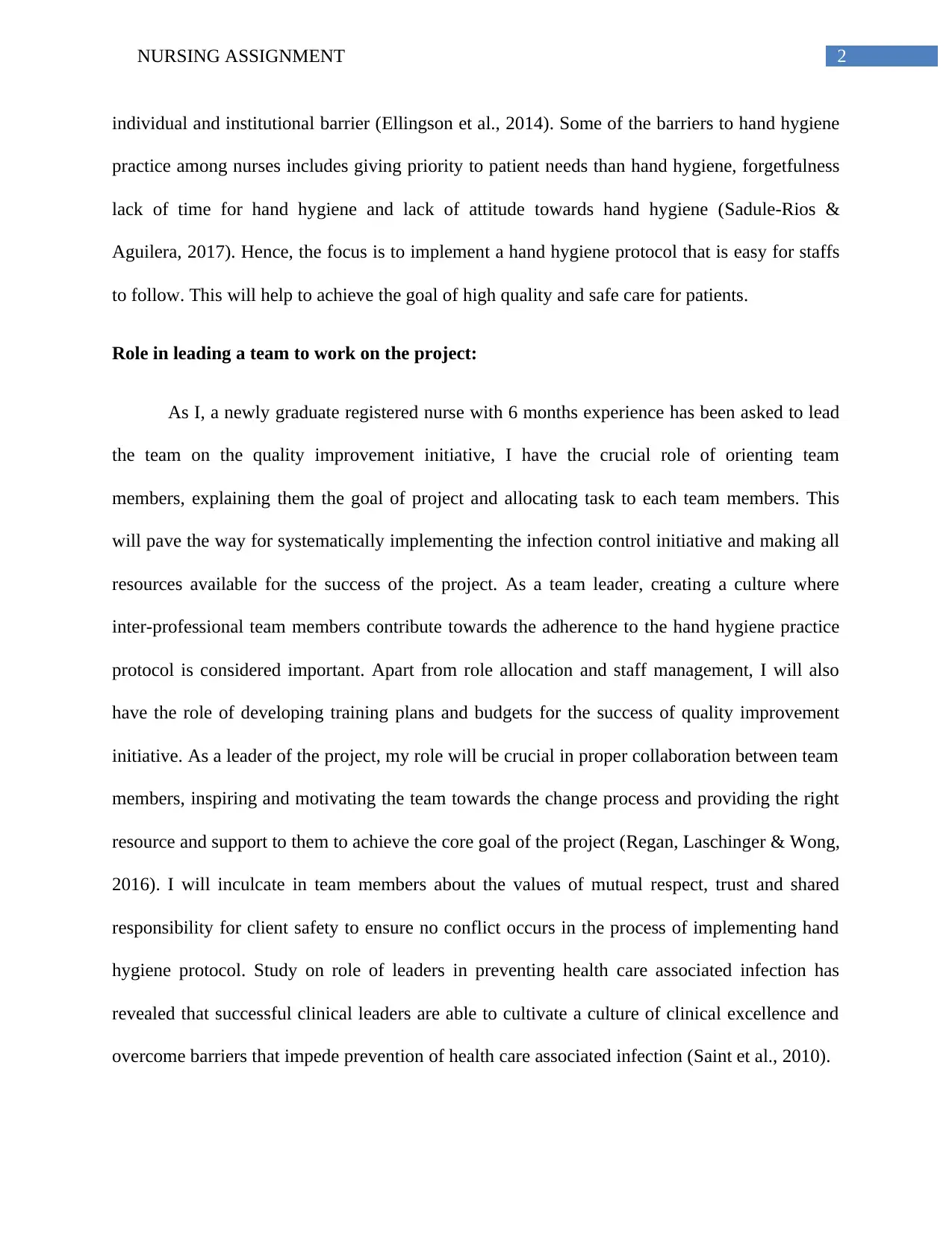
2NURSING ASSIGNMENT
individual and institutional barrier (Ellingson et al., 2014). Some of the barriers to hand hygiene
practice among nurses includes giving priority to patient needs than hand hygiene, forgetfulness
lack of time for hand hygiene and lack of attitude towards hand hygiene (Sadule-Rios &
Aguilera, 2017). Hence, the focus is to implement a hand hygiene protocol that is easy for staffs
to follow. This will help to achieve the goal of high quality and safe care for patients.
Role in leading a team to work on the project:
As I, a newly graduate registered nurse with 6 months experience has been asked to lead
the team on the quality improvement initiative, I have the crucial role of orienting team
members, explaining them the goal of project and allocating task to each team members. This
will pave the way for systematically implementing the infection control initiative and making all
resources available for the success of the project. As a team leader, creating a culture where
inter-professional team members contribute towards the adherence to the hand hygiene practice
protocol is considered important. Apart from role allocation and staff management, I will also
have the role of developing training plans and budgets for the success of quality improvement
initiative. As a leader of the project, my role will be crucial in proper collaboration between team
members, inspiring and motivating the team towards the change process and providing the right
resource and support to them to achieve the core goal of the project (Regan, Laschinger & Wong,
2016). I will inculcate in team members about the values of mutual respect, trust and shared
responsibility for client safety to ensure no conflict occurs in the process of implementing hand
hygiene protocol. Study on role of leaders in preventing health care associated infection has
revealed that successful clinical leaders are able to cultivate a culture of clinical excellence and
overcome barriers that impede prevention of health care associated infection (Saint et al., 2010).
individual and institutional barrier (Ellingson et al., 2014). Some of the barriers to hand hygiene
practice among nurses includes giving priority to patient needs than hand hygiene, forgetfulness
lack of time for hand hygiene and lack of attitude towards hand hygiene (Sadule-Rios &
Aguilera, 2017). Hence, the focus is to implement a hand hygiene protocol that is easy for staffs
to follow. This will help to achieve the goal of high quality and safe care for patients.
Role in leading a team to work on the project:
As I, a newly graduate registered nurse with 6 months experience has been asked to lead
the team on the quality improvement initiative, I have the crucial role of orienting team
members, explaining them the goal of project and allocating task to each team members. This
will pave the way for systematically implementing the infection control initiative and making all
resources available for the success of the project. As a team leader, creating a culture where
inter-professional team members contribute towards the adherence to the hand hygiene practice
protocol is considered important. Apart from role allocation and staff management, I will also
have the role of developing training plans and budgets for the success of quality improvement
initiative. As a leader of the project, my role will be crucial in proper collaboration between team
members, inspiring and motivating the team towards the change process and providing the right
resource and support to them to achieve the core goal of the project (Regan, Laschinger & Wong,
2016). I will inculcate in team members about the values of mutual respect, trust and shared
responsibility for client safety to ensure no conflict occurs in the process of implementing hand
hygiene protocol. Study on role of leaders in preventing health care associated infection has
revealed that successful clinical leaders are able to cultivate a culture of clinical excellence and
overcome barriers that impede prevention of health care associated infection (Saint et al., 2010).
⊘ This is a preview!⊘
Do you want full access?
Subscribe today to unlock all pages.

Trusted by 1+ million students worldwide
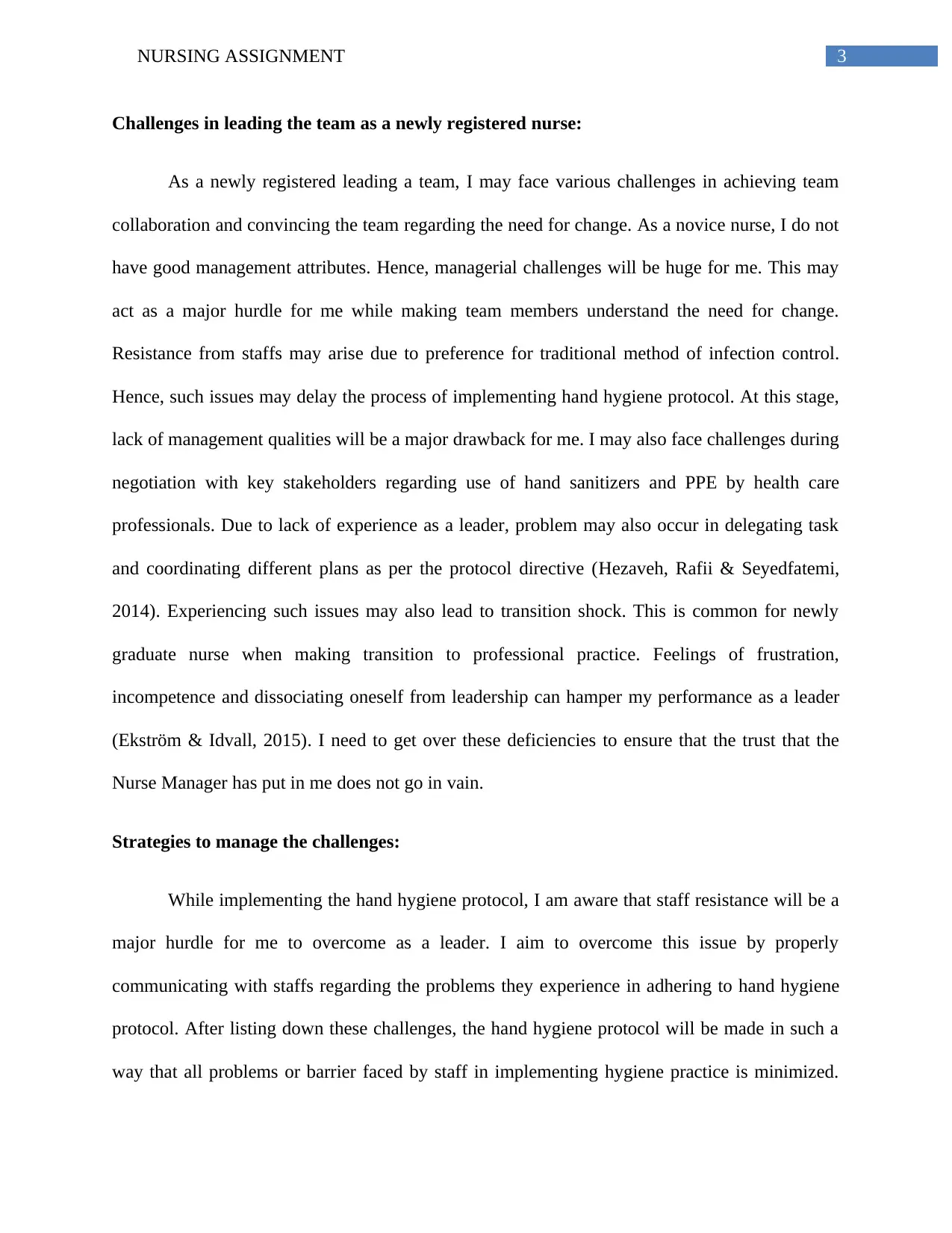
3NURSING ASSIGNMENT
Challenges in leading the team as a newly registered nurse:
As a newly registered leading a team, I may face various challenges in achieving team
collaboration and convincing the team regarding the need for change. As a novice nurse, I do not
have good management attributes. Hence, managerial challenges will be huge for me. This may
act as a major hurdle for me while making team members understand the need for change.
Resistance from staffs may arise due to preference for traditional method of infection control.
Hence, such issues may delay the process of implementing hand hygiene protocol. At this stage,
lack of management qualities will be a major drawback for me. I may also face challenges during
negotiation with key stakeholders regarding use of hand sanitizers and PPE by health care
professionals. Due to lack of experience as a leader, problem may also occur in delegating task
and coordinating different plans as per the protocol directive (Hezaveh, Rafii & Seyedfatemi,
2014). Experiencing such issues may also lead to transition shock. This is common for newly
graduate nurse when making transition to professional practice. Feelings of frustration,
incompetence and dissociating oneself from leadership can hamper my performance as a leader
(Ekström & Idvall, 2015). I need to get over these deficiencies to ensure that the trust that the
Nurse Manager has put in me does not go in vain.
Strategies to manage the challenges:
While implementing the hand hygiene protocol, I am aware that staff resistance will be a
major hurdle for me to overcome as a leader. I aim to overcome this issue by properly
communicating with staffs regarding the problems they experience in adhering to hand hygiene
protocol. After listing down these challenges, the hand hygiene protocol will be made in such a
way that all problems or barrier faced by staff in implementing hygiene practice is minimized.
Challenges in leading the team as a newly registered nurse:
As a newly registered leading a team, I may face various challenges in achieving team
collaboration and convincing the team regarding the need for change. As a novice nurse, I do not
have good management attributes. Hence, managerial challenges will be huge for me. This may
act as a major hurdle for me while making team members understand the need for change.
Resistance from staffs may arise due to preference for traditional method of infection control.
Hence, such issues may delay the process of implementing hand hygiene protocol. At this stage,
lack of management qualities will be a major drawback for me. I may also face challenges during
negotiation with key stakeholders regarding use of hand sanitizers and PPE by health care
professionals. Due to lack of experience as a leader, problem may also occur in delegating task
and coordinating different plans as per the protocol directive (Hezaveh, Rafii & Seyedfatemi,
2014). Experiencing such issues may also lead to transition shock. This is common for newly
graduate nurse when making transition to professional practice. Feelings of frustration,
incompetence and dissociating oneself from leadership can hamper my performance as a leader
(Ekström & Idvall, 2015). I need to get over these deficiencies to ensure that the trust that the
Nurse Manager has put in me does not go in vain.
Strategies to manage the challenges:
While implementing the hand hygiene protocol, I am aware that staff resistance will be a
major hurdle for me to overcome as a leader. I aim to overcome this issue by properly
communicating with staffs regarding the problems they experience in adhering to hand hygiene
protocol. After listing down these challenges, the hand hygiene protocol will be made in such a
way that all problems or barrier faced by staff in implementing hygiene practice is minimized.
Paraphrase This Document
Need a fresh take? Get an instant paraphrase of this document with our AI Paraphraser
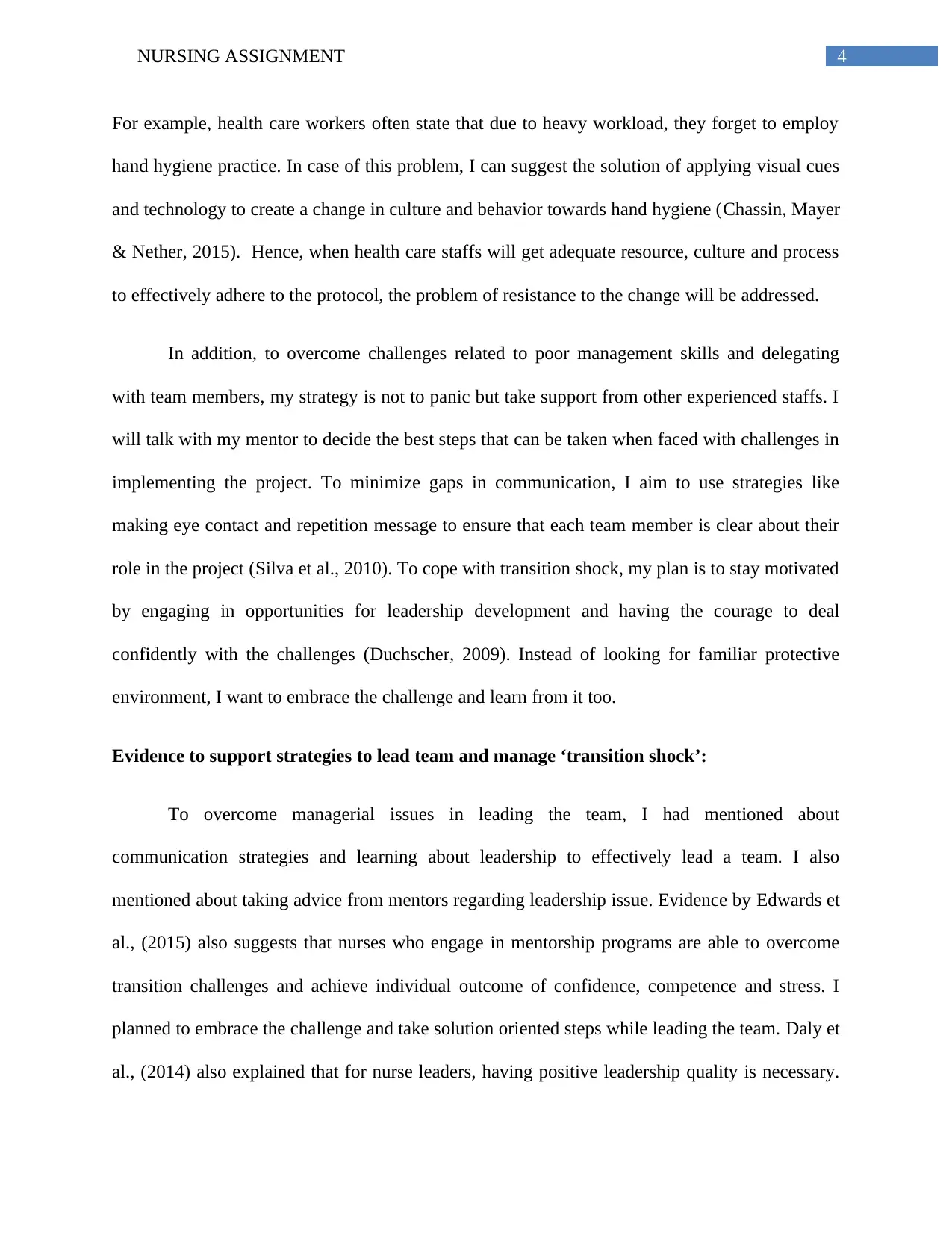
4NURSING ASSIGNMENT
For example, health care workers often state that due to heavy workload, they forget to employ
hand hygiene practice. In case of this problem, I can suggest the solution of applying visual cues
and technology to create a change in culture and behavior towards hand hygiene (Chassin, Mayer
& Nether, 2015). Hence, when health care staffs will get adequate resource, culture and process
to effectively adhere to the protocol, the problem of resistance to the change will be addressed.
In addition, to overcome challenges related to poor management skills and delegating
with team members, my strategy is not to panic but take support from other experienced staffs. I
will talk with my mentor to decide the best steps that can be taken when faced with challenges in
implementing the project. To minimize gaps in communication, I aim to use strategies like
making eye contact and repetition message to ensure that each team member is clear about their
role in the project (Silva et al., 2010). To cope with transition shock, my plan is to stay motivated
by engaging in opportunities for leadership development and having the courage to deal
confidently with the challenges (Duchscher, 2009). Instead of looking for familiar protective
environment, I want to embrace the challenge and learn from it too.
Evidence to support strategies to lead team and manage ‘transition shock’:
To overcome managerial issues in leading the team, I had mentioned about
communication strategies and learning about leadership to effectively lead a team. I also
mentioned about taking advice from mentors regarding leadership issue. Evidence by Edwards et
al., (2015) also suggests that nurses who engage in mentorship programs are able to overcome
transition challenges and achieve individual outcome of confidence, competence and stress. I
planned to embrace the challenge and take solution oriented steps while leading the team. Daly et
al., (2014) also explained that for nurse leaders, having positive leadership quality is necessary.
For example, health care workers often state that due to heavy workload, they forget to employ
hand hygiene practice. In case of this problem, I can suggest the solution of applying visual cues
and technology to create a change in culture and behavior towards hand hygiene (Chassin, Mayer
& Nether, 2015). Hence, when health care staffs will get adequate resource, culture and process
to effectively adhere to the protocol, the problem of resistance to the change will be addressed.
In addition, to overcome challenges related to poor management skills and delegating
with team members, my strategy is not to panic but take support from other experienced staffs. I
will talk with my mentor to decide the best steps that can be taken when faced with challenges in
implementing the project. To minimize gaps in communication, I aim to use strategies like
making eye contact and repetition message to ensure that each team member is clear about their
role in the project (Silva et al., 2010). To cope with transition shock, my plan is to stay motivated
by engaging in opportunities for leadership development and having the courage to deal
confidently with the challenges (Duchscher, 2009). Instead of looking for familiar protective
environment, I want to embrace the challenge and learn from it too.
Evidence to support strategies to lead team and manage ‘transition shock’:
To overcome managerial issues in leading the team, I had mentioned about
communication strategies and learning about leadership to effectively lead a team. I also
mentioned about taking advice from mentors regarding leadership issue. Evidence by Edwards et
al., (2015) also suggests that nurses who engage in mentorship programs are able to overcome
transition challenges and achieve individual outcome of confidence, competence and stress. I
planned to embrace the challenge and take solution oriented steps while leading the team. Daly et
al., (2014) also explained that for nurse leaders, having positive leadership quality is necessary.
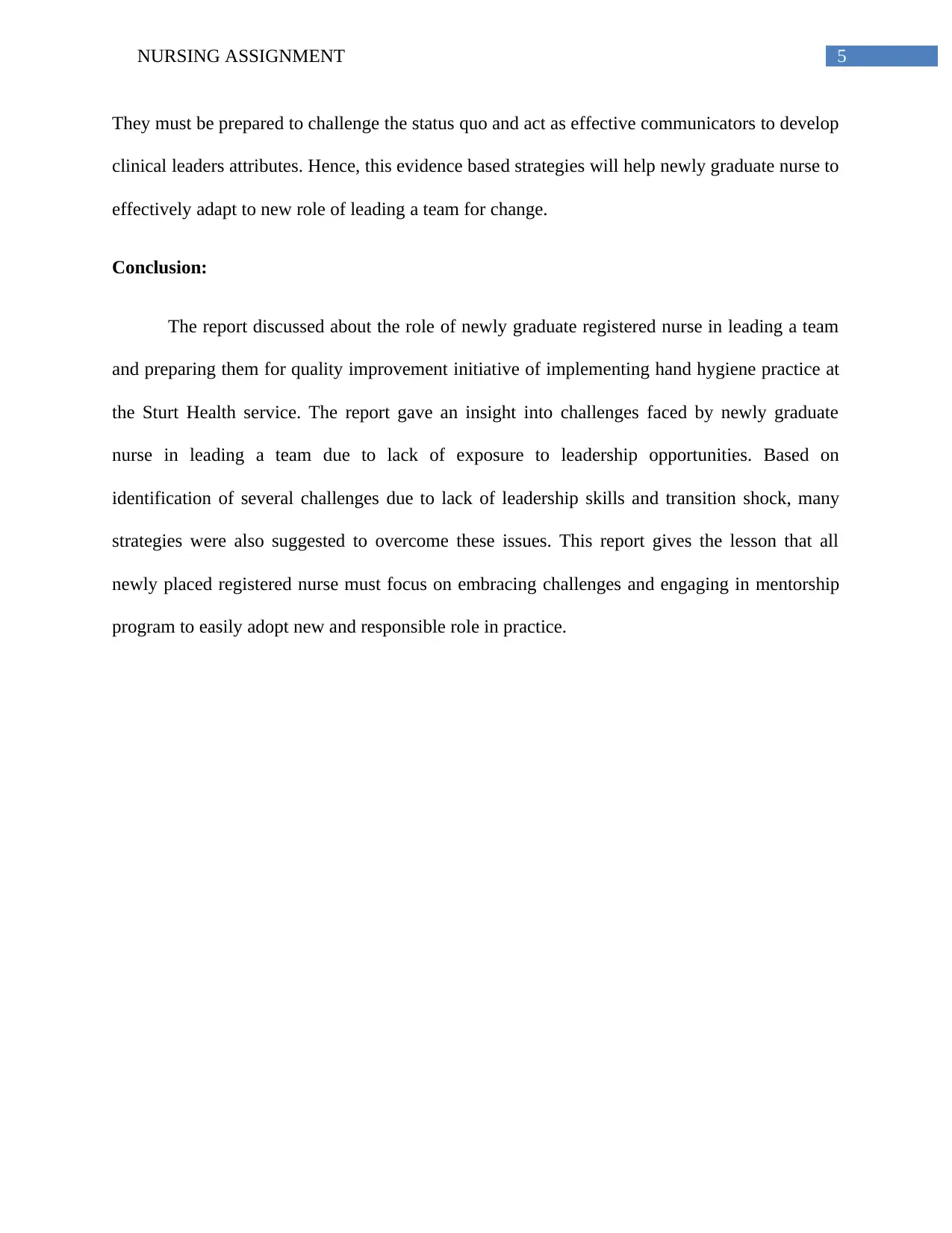
5NURSING ASSIGNMENT
They must be prepared to challenge the status quo and act as effective communicators to develop
clinical leaders attributes. Hence, this evidence based strategies will help newly graduate nurse to
effectively adapt to new role of leading a team for change.
Conclusion:
The report discussed about the role of newly graduate registered nurse in leading a team
and preparing them for quality improvement initiative of implementing hand hygiene practice at
the Sturt Health service. The report gave an insight into challenges faced by newly graduate
nurse in leading a team due to lack of exposure to leadership opportunities. Based on
identification of several challenges due to lack of leadership skills and transition shock, many
strategies were also suggested to overcome these issues. This report gives the lesson that all
newly placed registered nurse must focus on embracing challenges and engaging in mentorship
program to easily adopt new and responsible role in practice.
They must be prepared to challenge the status quo and act as effective communicators to develop
clinical leaders attributes. Hence, this evidence based strategies will help newly graduate nurse to
effectively adapt to new role of leading a team for change.
Conclusion:
The report discussed about the role of newly graduate registered nurse in leading a team
and preparing them for quality improvement initiative of implementing hand hygiene practice at
the Sturt Health service. The report gave an insight into challenges faced by newly graduate
nurse in leading a team due to lack of exposure to leadership opportunities. Based on
identification of several challenges due to lack of leadership skills and transition shock, many
strategies were also suggested to overcome these issues. This report gives the lesson that all
newly placed registered nurse must focus on embracing challenges and engaging in mentorship
program to easily adopt new and responsible role in practice.
⊘ This is a preview!⊘
Do you want full access?
Subscribe today to unlock all pages.

Trusted by 1+ million students worldwide
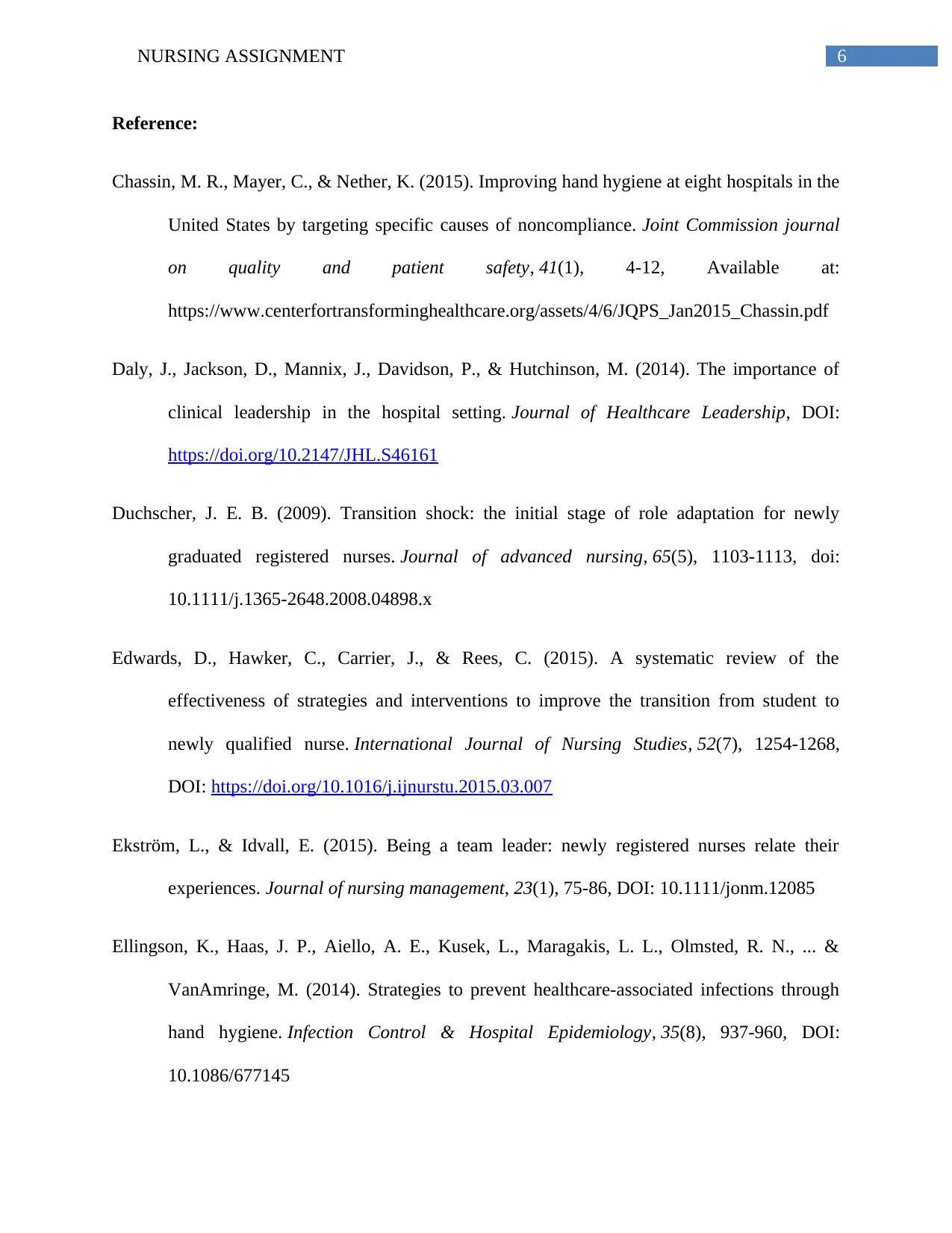
6NURSING ASSIGNMENT
Reference:
Chassin, M. R., Mayer, C., & Nether, K. (2015). Improving hand hygiene at eight hospitals in the
United States by targeting specific causes of noncompliance. Joint Commission journal
on quality and patient safety, 41(1), 4-12, Available at:
https://www.centerfortransforminghealthcare.org/assets/4/6/JQPS_Jan2015_Chassin.pdf
Daly, J., Jackson, D., Mannix, J., Davidson, P., & Hutchinson, M. (2014). The importance of
clinical leadership in the hospital setting. Journal of Healthcare Leadership, DOI:
https://doi.org/10.2147/JHL.S46161
Duchscher, J. E. B. (2009). Transition shock: the initial stage of role adaptation for newly
graduated registered nurses. Journal of advanced nursing, 65(5), 1103-1113, doi:
10.1111/j.1365-2648.2008.04898.x
Edwards, D., Hawker, C., Carrier, J., & Rees, C. (2015). A systematic review of the
effectiveness of strategies and interventions to improve the transition from student to
newly qualified nurse. International Journal of Nursing Studies, 52(7), 1254-1268,
DOI: https://doi.org/10.1016/j.ijnurstu.2015.03.007
Ekström, L., & Idvall, E. (2015). Being a team leader: newly registered nurses relate their
experiences. Journal of nursing management, 23(1), 75-86, DOI: 10.1111/jonm.12085
Ellingson, K., Haas, J. P., Aiello, A. E., Kusek, L., Maragakis, L. L., Olmsted, R. N., ... &
VanAmringe, M. (2014). Strategies to prevent healthcare-associated infections through
hand hygiene. Infection Control & Hospital Epidemiology, 35(8), 937-960, DOI:
10.1086/677145
Reference:
Chassin, M. R., Mayer, C., & Nether, K. (2015). Improving hand hygiene at eight hospitals in the
United States by targeting specific causes of noncompliance. Joint Commission journal
on quality and patient safety, 41(1), 4-12, Available at:
https://www.centerfortransforminghealthcare.org/assets/4/6/JQPS_Jan2015_Chassin.pdf
Daly, J., Jackson, D., Mannix, J., Davidson, P., & Hutchinson, M. (2014). The importance of
clinical leadership in the hospital setting. Journal of Healthcare Leadership, DOI:
https://doi.org/10.2147/JHL.S46161
Duchscher, J. E. B. (2009). Transition shock: the initial stage of role adaptation for newly
graduated registered nurses. Journal of advanced nursing, 65(5), 1103-1113, doi:
10.1111/j.1365-2648.2008.04898.x
Edwards, D., Hawker, C., Carrier, J., & Rees, C. (2015). A systematic review of the
effectiveness of strategies and interventions to improve the transition from student to
newly qualified nurse. International Journal of Nursing Studies, 52(7), 1254-1268,
DOI: https://doi.org/10.1016/j.ijnurstu.2015.03.007
Ekström, L., & Idvall, E. (2015). Being a team leader: newly registered nurses relate their
experiences. Journal of nursing management, 23(1), 75-86, DOI: 10.1111/jonm.12085
Ellingson, K., Haas, J. P., Aiello, A. E., Kusek, L., Maragakis, L. L., Olmsted, R. N., ... &
VanAmringe, M. (2014). Strategies to prevent healthcare-associated infections through
hand hygiene. Infection Control & Hospital Epidemiology, 35(8), 937-960, DOI:
10.1086/677145
Paraphrase This Document
Need a fresh take? Get an instant paraphrase of this document with our AI Paraphraser
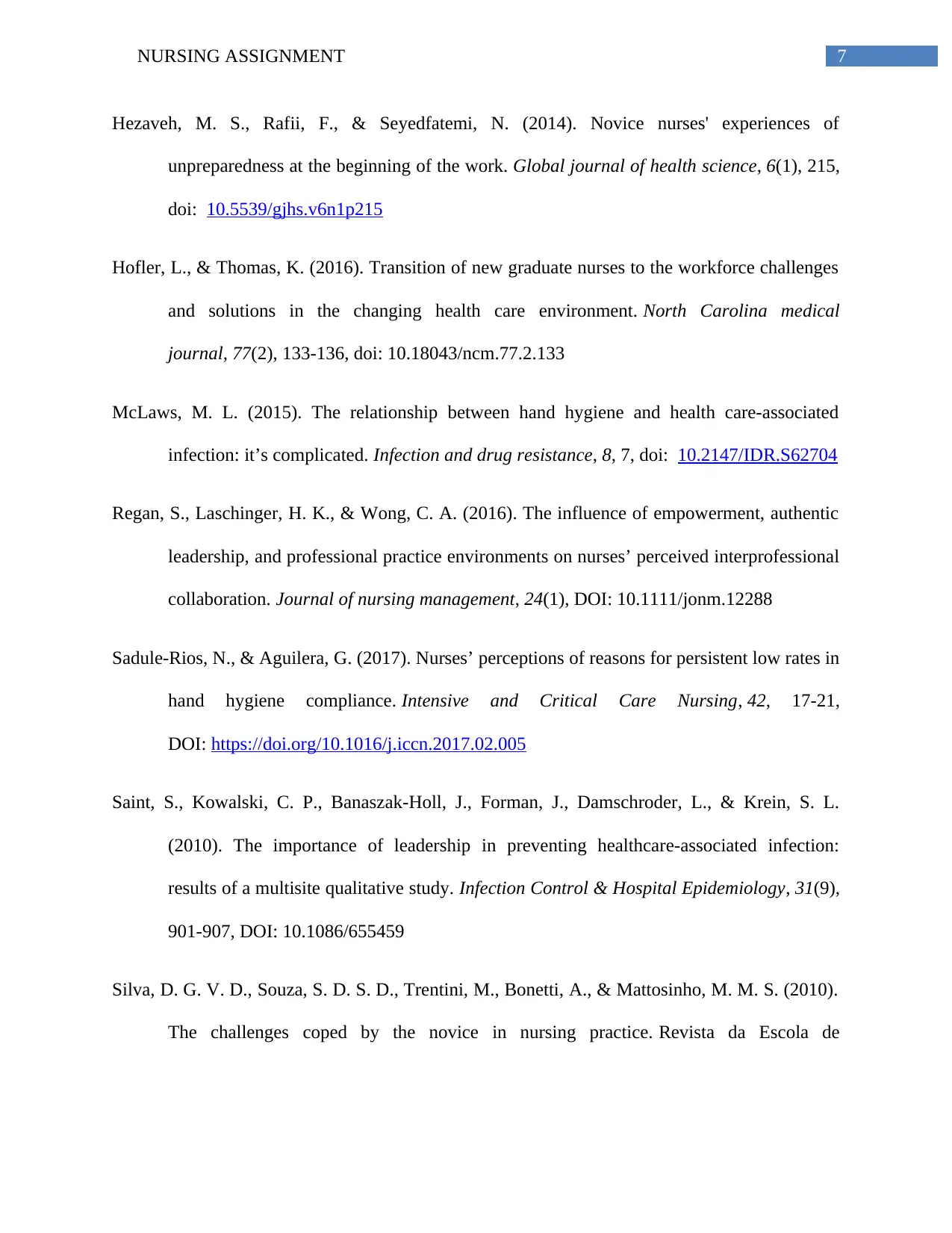
7NURSING ASSIGNMENT
Hezaveh, M. S., Rafii, F., & Seyedfatemi, N. (2014). Novice nurses' experiences of
unpreparedness at the beginning of the work. Global journal of health science, 6(1), 215,
doi: 10.5539/gjhs.v6n1p215
Hofler, L., & Thomas, K. (2016). Transition of new graduate nurses to the workforce challenges
and solutions in the changing health care environment. North Carolina medical
journal, 77(2), 133-136, doi: 10.18043/ncm.77.2.133
McLaws, M. L. (2015). The relationship between hand hygiene and health care-associated
infection: it’s complicated. Infection and drug resistance, 8, 7, doi: 10.2147/IDR.S62704
Regan, S., Laschinger, H. K., & Wong, C. A. (2016). The influence of empowerment, authentic
leadership, and professional practice environments on nurses’ perceived interprofessional
collaboration. Journal of nursing management, 24(1), DOI: 10.1111/jonm.12288
Sadule-Rios, N., & Aguilera, G. (2017). Nurses’ perceptions of reasons for persistent low rates in
hand hygiene compliance. Intensive and Critical Care Nursing, 42, 17-21,
DOI: https://doi.org/10.1016/j.iccn.2017.02.005
Saint, S., Kowalski, C. P., Banaszak-Holl, J., Forman, J., Damschroder, L., & Krein, S. L.
(2010). The importance of leadership in preventing healthcare-associated infection:
results of a multisite qualitative study. Infection Control & Hospital Epidemiology, 31(9),
901-907, DOI: 10.1086/655459
Silva, D. G. V. D., Souza, S. D. S. D., Trentini, M., Bonetti, A., & Mattosinho, M. M. S. (2010).
The challenges coped by the novice in nursing practice. Revista da Escola de
Hezaveh, M. S., Rafii, F., & Seyedfatemi, N. (2014). Novice nurses' experiences of
unpreparedness at the beginning of the work. Global journal of health science, 6(1), 215,
doi: 10.5539/gjhs.v6n1p215
Hofler, L., & Thomas, K. (2016). Transition of new graduate nurses to the workforce challenges
and solutions in the changing health care environment. North Carolina medical
journal, 77(2), 133-136, doi: 10.18043/ncm.77.2.133
McLaws, M. L. (2015). The relationship between hand hygiene and health care-associated
infection: it’s complicated. Infection and drug resistance, 8, 7, doi: 10.2147/IDR.S62704
Regan, S., Laschinger, H. K., & Wong, C. A. (2016). The influence of empowerment, authentic
leadership, and professional practice environments on nurses’ perceived interprofessional
collaboration. Journal of nursing management, 24(1), DOI: 10.1111/jonm.12288
Sadule-Rios, N., & Aguilera, G. (2017). Nurses’ perceptions of reasons for persistent low rates in
hand hygiene compliance. Intensive and Critical Care Nursing, 42, 17-21,
DOI: https://doi.org/10.1016/j.iccn.2017.02.005
Saint, S., Kowalski, C. P., Banaszak-Holl, J., Forman, J., Damschroder, L., & Krein, S. L.
(2010). The importance of leadership in preventing healthcare-associated infection:
results of a multisite qualitative study. Infection Control & Hospital Epidemiology, 31(9),
901-907, DOI: 10.1086/655459
Silva, D. G. V. D., Souza, S. D. S. D., Trentini, M., Bonetti, A., & Mattosinho, M. M. S. (2010).
The challenges coped by the novice in nursing practice. Revista da Escola de
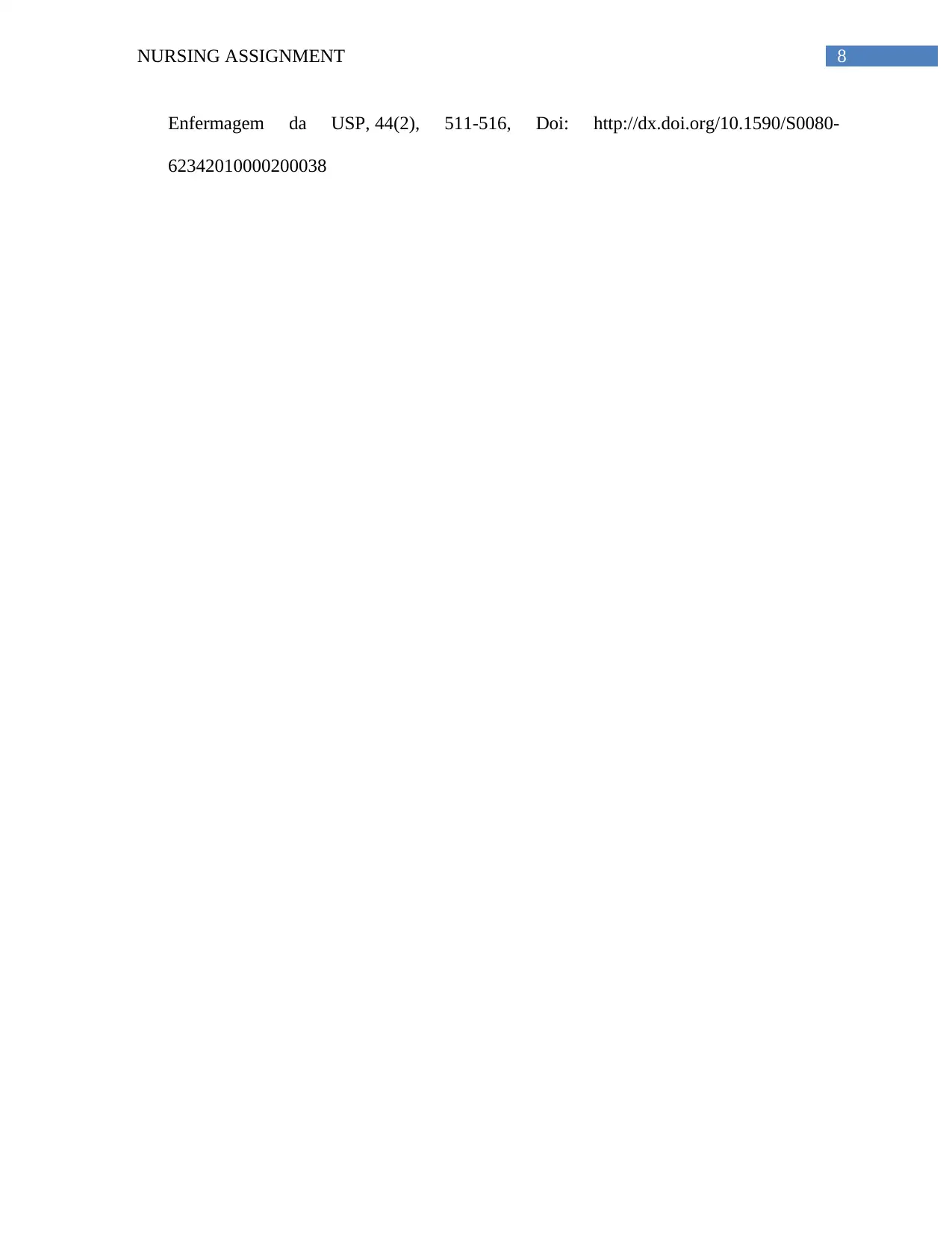
8NURSING ASSIGNMENT
Enfermagem da USP, 44(2), 511-516, Doi: http://dx.doi.org/10.1590/S0080-
62342010000200038
Enfermagem da USP, 44(2), 511-516, Doi: http://dx.doi.org/10.1590/S0080-
62342010000200038
⊘ This is a preview!⊘
Do you want full access?
Subscribe today to unlock all pages.

Trusted by 1+ million students worldwide
1 out of 9
Related Documents
Your All-in-One AI-Powered Toolkit for Academic Success.
+13062052269
info@desklib.com
Available 24*7 on WhatsApp / Email
![[object Object]](/_next/static/media/star-bottom.7253800d.svg)
Unlock your academic potential
Copyright © 2020–2025 A2Z Services. All Rights Reserved. Developed and managed by ZUCOL.





